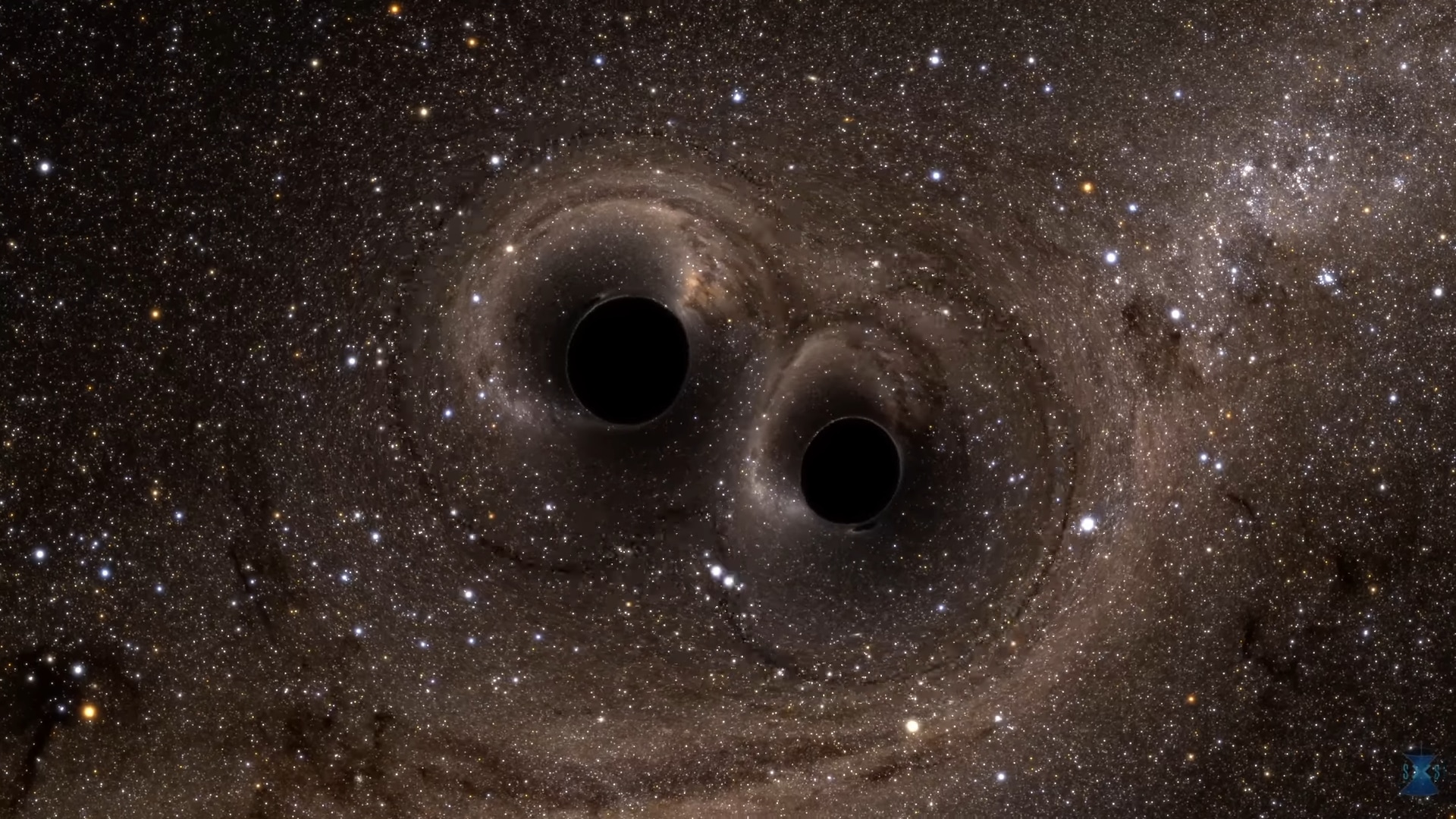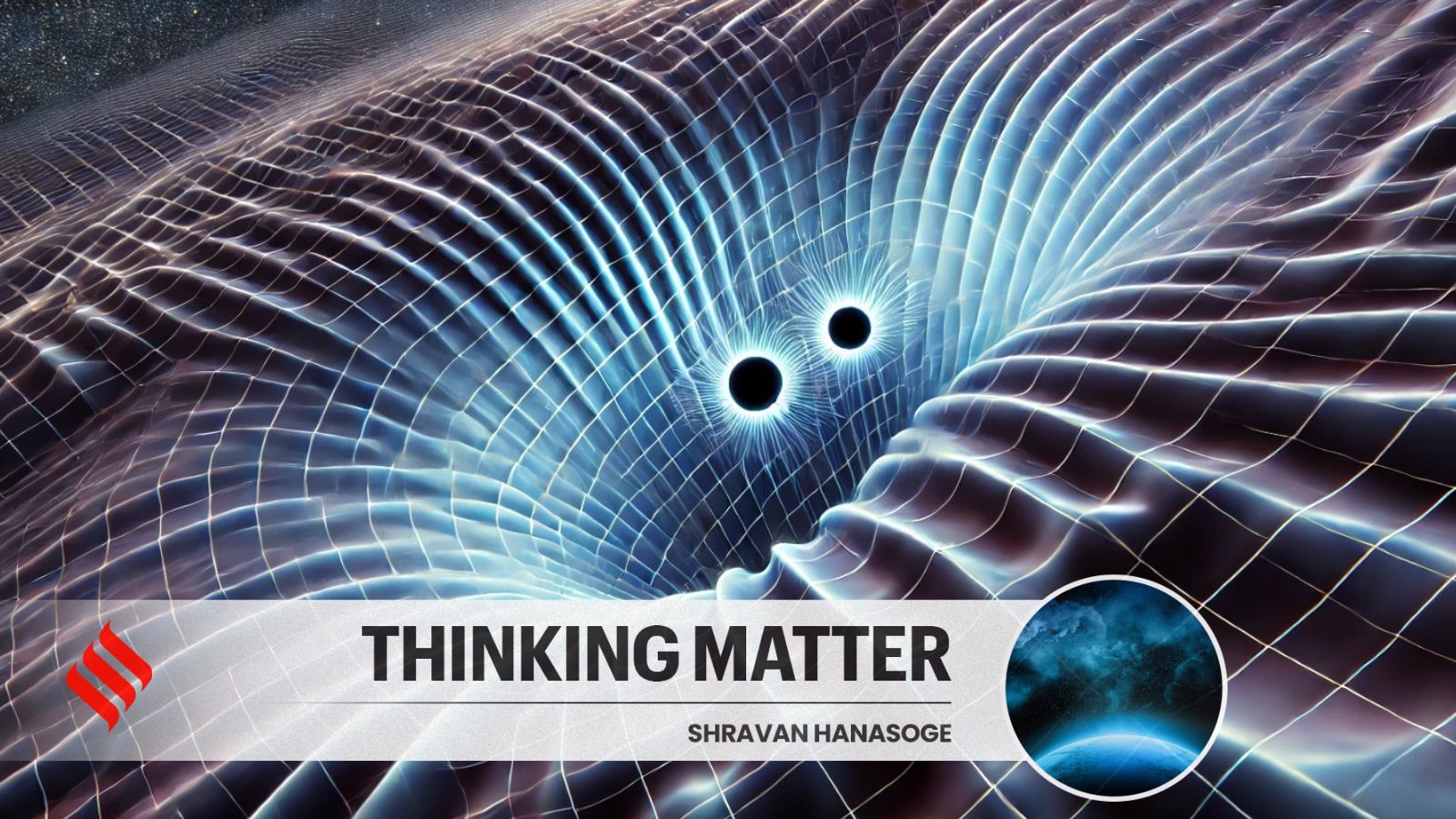Imagine a massive bell ringing somewhere across the cosmos — except the bell is two black holes crashing into each other, and the ringing is not sound, but ripples in space itself. These ripples, called gravitational waves, stretch and squeeze the very fabric of the universe.
Predicted by Albert Einstein in 1916 as a consequence of his general theory of relativity, they were dismissed even by Einstein himself as too faint to ever be detected. For nearly a century, they remained a ghostly prediction — until they were directly detected.
Gravitational waves are generated by some of the most violent events in the universe: the collision of black holes, the merging of neutron stars, the core collapse of massive stars. These events release staggering amounts of energy, more than the light from all the stars in all the galaxies combined, but in a form that doesn’t travel as light. Instead, it travels as tiny distortions in spacetime itself, moving outward like ripples from a stone tossed into a cosmic pond.
The problem is that, by the time these ripples reach Earth, they are unimaginably subtle. Detecting one requires measuring changes in distance thousands of times smaller than the width of a proton. That’s why the scientific world held its breath in 2016, when physicists announced that they had finally caught one — not just seen it, but heard it, like the chirp of two black holes spiraling into each other over a billion light-years away.
How LIGO heard the whispers
This triumph was the result of decades of relentless effort. The experiment that detected gravitational waves, known as LIGO (Laser Interferometer Gravitational-Wave Observatory), was built in the U.S. after years of skepticism, budget hurdles, and near cancellation.
The idea was elegant but extreme: split a laser beam and send the parts down two 4-kilometer-long tunnels at right angles, then bring them back together. If a gravitational wave passed through, it would ever-so-slightly alter the lengths of the arms, changing the interference pattern of the beams. Simple in concept, but a nightmare in practice . Engineers had to isolate the instrument from every tremor, hum, and vibration, from distant earthquakes to passing trucks.
 A computer simulation shows the collision of two black holes, a tremendously powerful event detected for the first time ever by the Laser Interferometer Gravitational-Wave Observatory, or LIGO. (Image: LIGO Labs)
A computer simulation shows the collision of two black holes, a tremendously powerful event detected for the first time ever by the Laser Interferometer Gravitational-Wave Observatory, or LIGO. (Image: LIGO Labs)
For years, LIGO ran without detecting anything. To make sure the team didn’t fool themselves with wishful thinking or instrument glitches, a small subgroup within the collaboration had a unique job: inject fake gravitational wave signals into the data stream without telling anyone else. These “blind injections” were designed to test whether the analysis team could detect them and verify their validity.
Story continues below this ad
Every time a new candidate event was found, the collaboration had to perform a ritual: open a sealed envelope that declared whether the signal was genuine or planted. It was only after one such dramatic envelope-opening that the team realized: this time, it was real.
In September 2015, just days after a major upgrade, LIGO observed its first confirmed signal — not a test, not a glitch, but an authentic cosmic whisper from two black holes colliding over a billion years ago. The scientific community was stunned. The detection not only confirmed a key prediction of Einstein’s theory, it opened a new way of observing the universe: through gravitational ears rather than electromagnetic eyes.
Striking gold on gravitational wave events
Since then, gravitational wave observatories around the world, including Virgo in Italy and KAGRA in Japan, have joined the effort, detecting dozens more events. Some have even seen the collision of neutron stars, which not only produced gravitational waves but also emitted light, allowing telescopes across Earth and in orbit to witness the event in multiple wavelengths. These “multi-messenger” events give scientists a much fuller picture of cosmic phenomena, from how gold is formed to the inner workings of extreme gravity.
In recognition of this groundbreaking achievement, the 2017 Nobel Prize in Physics was awarded to Rainer Weiss, Barry Barish, and Kip Thorne — three of the key architects behind LIGO — for their decisive contributions to the project. Their work opened up a new window on the universe.
General theory of relativity and gravitational waves
Story continues below this ad
Einstein’s General Theory of Relativity, published in 1915, redefined our understanding of gravity. Instead of being a force between masses, as Newton described, gravity in GR is the warping of space and time — or spacetime — caused by mass and energy. Massive objects like stars and planets bend the fabric of spacetime around them, and other objects move along those curves.
This elegant idea not only explained planetary motion more accurately than Newton’s laws, but also led to revolutionary predictions: time runs slower near massive objects, light can bend around stars, and ripples, or gravitational waves, should radiate outward when spacetime is disturbed.
Gravitational waves interact extremely weakly with matter. Unlike light, which can be blocked, scattered, or absorbed, gravitational waves pass straight through planets, stars, and even entire galaxies almost undisturbed. This makes them pristine messengers from the most violent corners of the universe, giving us access to events like black hole mergers that emit no light at all. But it also makes them devilishly hard to detect.
 Continuous gravitational waves are expected to be produced by a single spinning massive object like a neutron star. (Image Credit: Casey Reed/Penn State University)
Continuous gravitational waves are expected to be produced by a single spinning massive object like a neutron star. (Image Credit: Casey Reed/Penn State University)
Another fascinating consequence of general relativity is that gravitational waves don’t just carry information — they carry energy. As two massive objects spiral toward each other, they lose energy through these ripples, which causes them to draw closer and orbit faster. This “inspiral” speeds up until they collide.
Story continues below this ad
In fact, the gradual shortening of orbital periods in a pair of neutron stars (the Hulse-Taylor binary) was observed decades before LIGO, providing the first indirect evidence that gravitational waves are real. That discovery won a Nobel Prize in 1993, long before anyone had actually “heard” a gravitational wave.
Next stop: LISA
The search for gravitational waves doesn’t end here. The European Space Agency and NASA are collaborating on LISA (Laser Interferometer Space Antenna), a space-based gravitational wave observatory expected to launch in the 2030s. Unlike ground-based detectors, LISA will be able to sense lower-frequency gravitational waves from phenomena like supermassive black hole mergers and possibly even echoes from the early universe — if they exist.
India too has joined the global gravitational wave effort in a major way. As part of an international collaboration, it is building its own advanced gravitational wave observatory, LIGO-India, slated to be operational by the end of this decade. Located in Maharashtra and funded by the Department of Atomic Energy and Department of Science and Technology, this facility will enhance the global network’s ability to pinpoint the origin of gravitational waves and improve detection sensitivity. Its addition will put India at the heart of a new era in astrophysics.
Why does this matter to the rest of us? Because gravitational wave astronomy is more than a technical triumph — it’s a new sense organ for humanity. Just as Galileo’s telescope opened the heavens in the 17th century, LIGO and its successors are beginning to uncover a dark, dynamic universe we’ve never seen before. We are no longer just looking at the stars. We are now listening to the heartbeat of spacetime itself.
Story continues below this ad
Shravan Hanasoge is an astrophysicist at the Tata Institute of Fundamental Research.





Average Rating